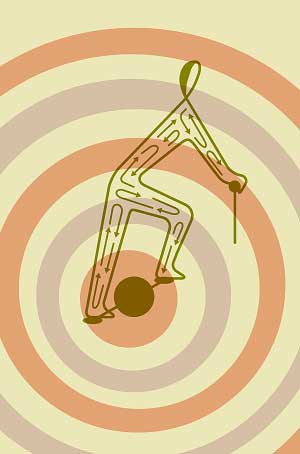 |
|
Short Take
A customized cycle provides blood-flow data
By Sara Selis
Illustration by Greg Mably
For most people, the words "MRI scan" conjure up the image of a patient lying motionless as he is transported inside the narrow bore of an MRI magnet. At Stanford Medical Center, though, a years-long collaboration among faculty in radiology, vascular surgery and mechanical engineering has made possible a completely different MRI experience, in which the patient sits upright inside the machine and pedals a custom-built exercise cycle.
The cycle, believed to be the first of its kind, enables Stanford researchers to precisely and noninvasively measure patients' blood flow while exercising. That information is giving researchers a better understanding of vascular disease as well as normal blood flow.
"If you want to understand a patient's blood flow, you need to see the patient in various physiological states," explains Charles Taylor, PhD, assistant professor of surgery and mechanical engineering, who, with Robert Herfkens, professor of radiology, is leading this effort. "Until now, we could accurately measure blood flow only when the patient was at rest and, with vascular disease, that's not enough." With some vascular disorders, symptoms become apparent only during physical activity.
The Exercise Challenge
MRI technology has been used for years to measure blood flow at rest, but obtaining such data on an exercising patient wasn't feasible for various reasons: The enclosed design of the standard-model MRI made doing exercise there difficult. No metal is permitted inside the magnet. And to ensure accurate readings, patients must remain still.
Researchers elsewhere have tried various methods to measure blood flow during exercise, but these carried drawbacks. One method involved inserting a catheter inside a femoral artery, but this approach was invasive and could temporarily alter the artery's normal function. Another strategy was to do an MRI scan on the patient immediately following exercise, but this yielded inaccurate results.
When Stanford Hospital acquired a high-powered, vertically open MRI in 1997, Taylor and Herfkens saw a chance to custom-design an exercise cycle for it. They assigned the project to a Stanford engineering class, which built a rudimentary, bulky prototype mostly of wood. After a year, it began to fall apart because of construction weaknesses. Following a second iteration, Chris Cheng, then a doctoral student in mechanical engineering, took on the project in winter 2000.
Cheng supervised a group of engineers led by Doug Schwandt at the Palo Alto Veterans Affairs Research & Development Center to design and construct a more durable, streamlined model. The final product, weighing about 80 pounds, consists mostly of beech wood and high-density plastic.
The cycle, which slides into rails at the bottom of the MRI, is essentially a set of pedals that provides resistance around a single wheel. A coil that detects blood flow in the thoracic and abdominal aorta wraps around the patient's torso and a heart-rate monitor rests on his or her finger.
As the patient pedals the cycle, achieving light to moderate exercise, the magnet gathers the blood-flow data and transmits it to a computer. When the images are interpreted by software Cheng developed, they indicate the rate at which blood is flowing through the artery and the forces exerted on the artery wall.
Stanford researchers are using the MRI cycle in research with healthy adults and patients with intermittent claudication, a condition in which blood flow to the legs is obstructed, causing stiffness and pain. The data from the healthy cyclers is helping researchers understand normal blood flow under various conditions. Data from the claudication patients, meanwhile, is shedding light on a common vascular disorder.
"This bike is a tool that lets us squeeze more information from this already-useful [MRI] machine," says Ronald Dalman, MD, associate professor of vascular surgery at Stanford and the VA Palo Alto Health Care System, who is using the cycle to monitor some of his patients. "In just a few minutes, you can get an incredible amount of useful data, which opens up new possibilities for understanding vascular disease."
Comments? Contact Stanford Medicine at

